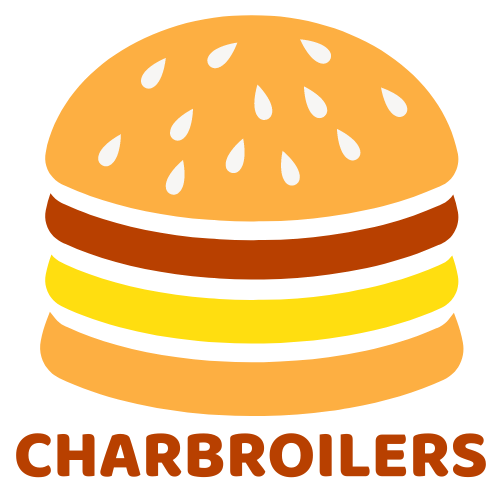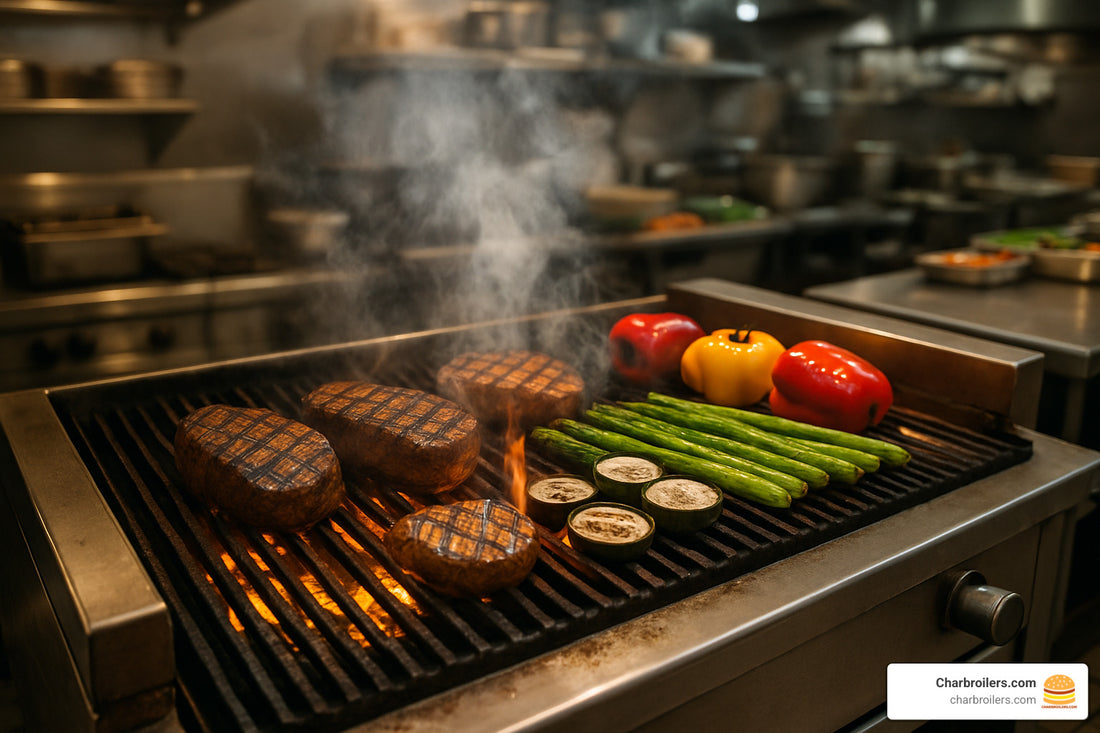
Getting Fired Up About Commercial Charbroilers
Share
Understanding Commercial Charbroilers: A Complete Guide
Commercial charbroilers are specialized cooking appliances designed to quickly sear meats and vegetables with high heat, creating distinctive grill marks and imparting that sought-after smoky flavor that customers love. Here's what you need to know:
- Definition: A cooking appliance with grates positioned above a powerful heat source
- Types: Countertop, freestanding, modular, and outdoor models
- Heat Sources: Gas, electric, infrared, lava rock, and ceramic radiant
- Sizes: Available from compact 12" to expansive 84" widths
- Key Benefits: Creates signature grill marks, adds smoky flavor, enables high-volume cooking
Commercial charbroilers stand as essential equipment for restaurants looking to deliver authentic grilled flavors and those distinctive sear marks that signal quality to diners. Whether you're operating a busy steakhouse, a food truck with limited space, or a high-volume diner, the right charbroiler can dramatically improve your menu offerings while streamlining your kitchen workflow.
These powerful units generate intense heat—with some models delivering up to 40,000 BTU per burner—allowing chefs to quickly cook steaks, burgers, chicken, and vegetables to perfection. The choice between countertop models (ideal for smaller kitchens) and freestanding units (perfect for high-volume operations) depends largely on your available space and production needs.
I'm Sean Kearney, founder of Charbroilers.com with over a decade of experience helping restaurant owners find the perfect commercial charbroilers for their unique kitchen setups. Throughout my career, I've guided countless chefs through the selection process to ensure they get equipment that balances performance, durability, and value.
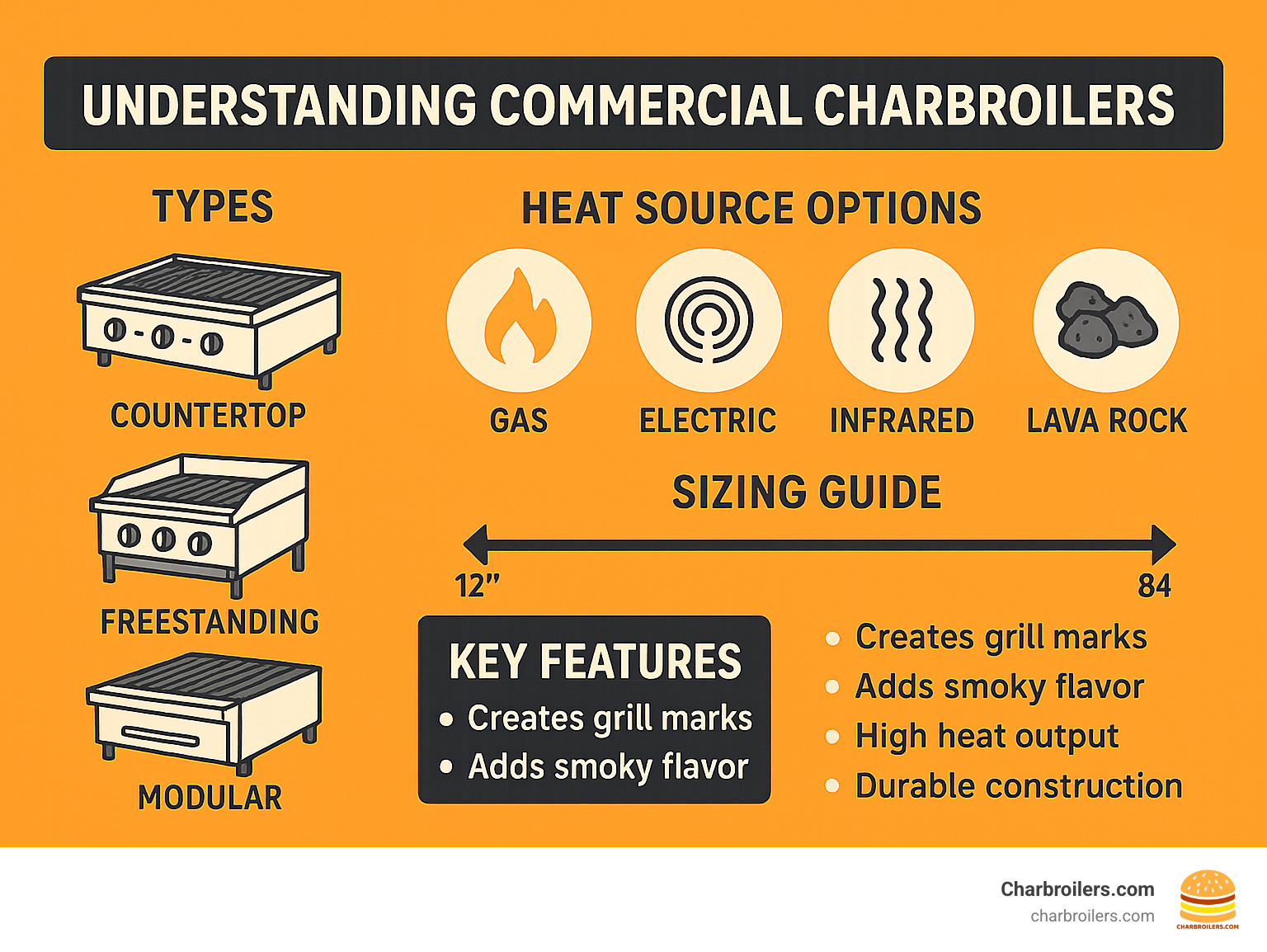
Why This Guide Matters
In today's competitive restaurant landscape, menu differentiation is more important than ever. Charbroiled items consistently rank among customer favorites, with their distinctive flavor profile and visual appeal creating memorable dining experiences that keep patrons coming back.
The right commercial charbroiler represents a significant investment in your kitchen's capabilities, with returns that extend beyond just cooking performance. At Charbroilers.com, we've seen how the perfect broiler can reduce cooking times, increase throughput during peak hours, and create signature menu items that define a restaurant's brand.
This comprehensive guide will help you steer the options available, understand the technical considerations, and make an informed decision that aligns with your culinary vision, kitchen constraints, and budget realities.
How Commercial Charbroilers Work
At their core, commercial charbroilers operate on a simple yet fascinating principle: food cooks on grates positioned above an intense heat source. But there's so much more to this kitchen workhorse than meets the eye!
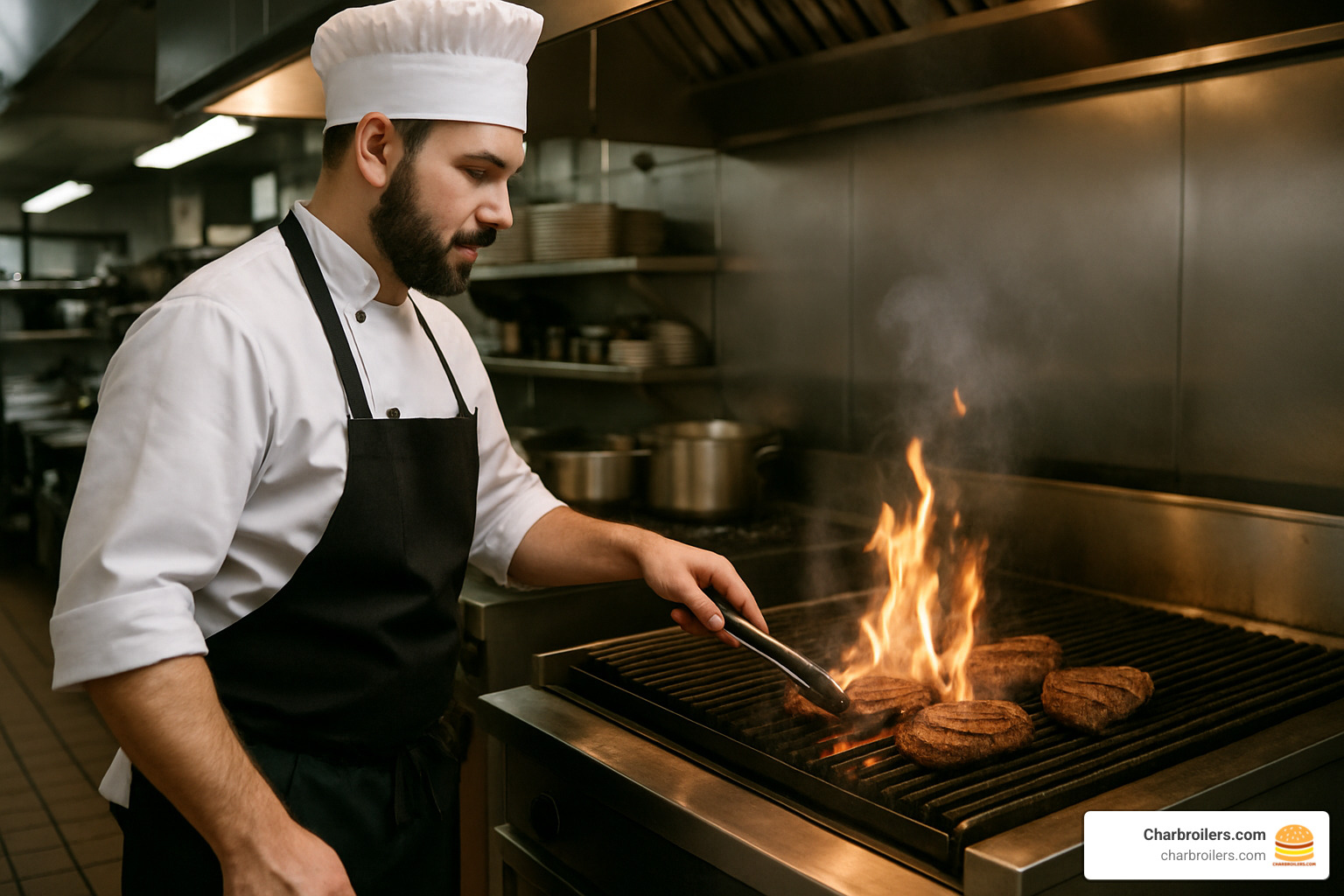
Think of your charbroiler as a three-pronged cooking powerhouse. First, there's conduction happening when those sizzling hot grates make direct contact with your steaks or vegetables. Then there's radiation – those invisible heat waves rising up from below. And finally, convection comes into play as hot air circulates around your food, ensuring even cooking.
The real magic? It happens when those flavorful drippings fall onto the heat source below. In what I like to call the "flavor dance," these juices instantly vaporize and rise back up to accept your food with that unmistakable smoky essence that customers crave. This natural flavor improvement is what truly sets charbroiling apart from other cooking methods.
Most commercial charbroilers feature distinct heat zones – a game-changer for busy kitchens. Your grill cooks can smoothly transition items between hotter areas for perfect searing and cooler zones for finishing, all on the same cooking surface. Higher-end models take this flexibility even further with independent burner controls, letting you customize temperature zones across the entire grill.
When shopping for gas models, you'll notice BTU ratings (British Thermal Units) that indicate heat output. Commercial units typically deliver impressive power, ranging from 15,000 to 40,000 BTU per burner. Electric models measure their muscle in kilowatts (kW) instead, but deliver comparable cooking capabilities for kitchens without gas access.
Safety isn't optional in a busy restaurant, which is why proper ventilation is non-negotiable with these heat powerhouses. Type I hood systems with fire suppression capabilities aren't just good practice – they're standard requirements in most jurisdictions. At Charbroilers.com, we ensure all our equipment meets or exceeds NSF and ETL safety standards, giving you both peace of mind and exceptional cooking performance.
Your charbroiler's thermostat and flame control systems work together to maintain consistent cooking temperatures, essential for high-volume kitchens where consistency is king. And while these workhorses generate serious heat, modern designs have dramatically improved energy efficiency without sacrificing cooking power.
Types of Commercial Charbroilers
When you're setting up a kitchen, choosing the right commercial charbroiler is like finding the perfect pair of shoes – it needs to fit your space, support your daily workload, and feel just right for your style. Let's explore the main types you'll encounter in your search.
Countertop Charbroilers in Tight Spaces
If your kitchen resembles a cozy apartment rather than a spacious ballroom, countertop models will be your best friend. These compact powerhouses deliver impressive cooking capacity without hogging valuable floor space.
Countertop commercial charbroilers sit comfortably on standard 24" to 36" deep work surfaces, making them perfect for food trucks, small cafés, and quick-service restaurants where every inch counts. They're available in widths ranging from just 12" all the way up to 48", so you can match the size precisely to your production needs.
What I love about these models is their versatility. Need to reconfigure your kitchen for a special event? These units can be moved around with relative ease. Running a seasonal operation? They're much easier to store during off-periods than their larger cousins.
Many of our customers who operate food trucks tell us their countertop charbroilers are the workhorses of their mobile kitchens, cranking out burgers and grilled sandwiches during the lunch rush with impressive efficiency despite their modest footprint.
Freestanding Heavy-Duty Stations
For the serious grilling operation – think busy steakhouses, high-volume diners, and large-scale catering kitchens – freestanding floor models deliver the cooking equivalent of a freight train: powerful, reliable, and built for the long haul.
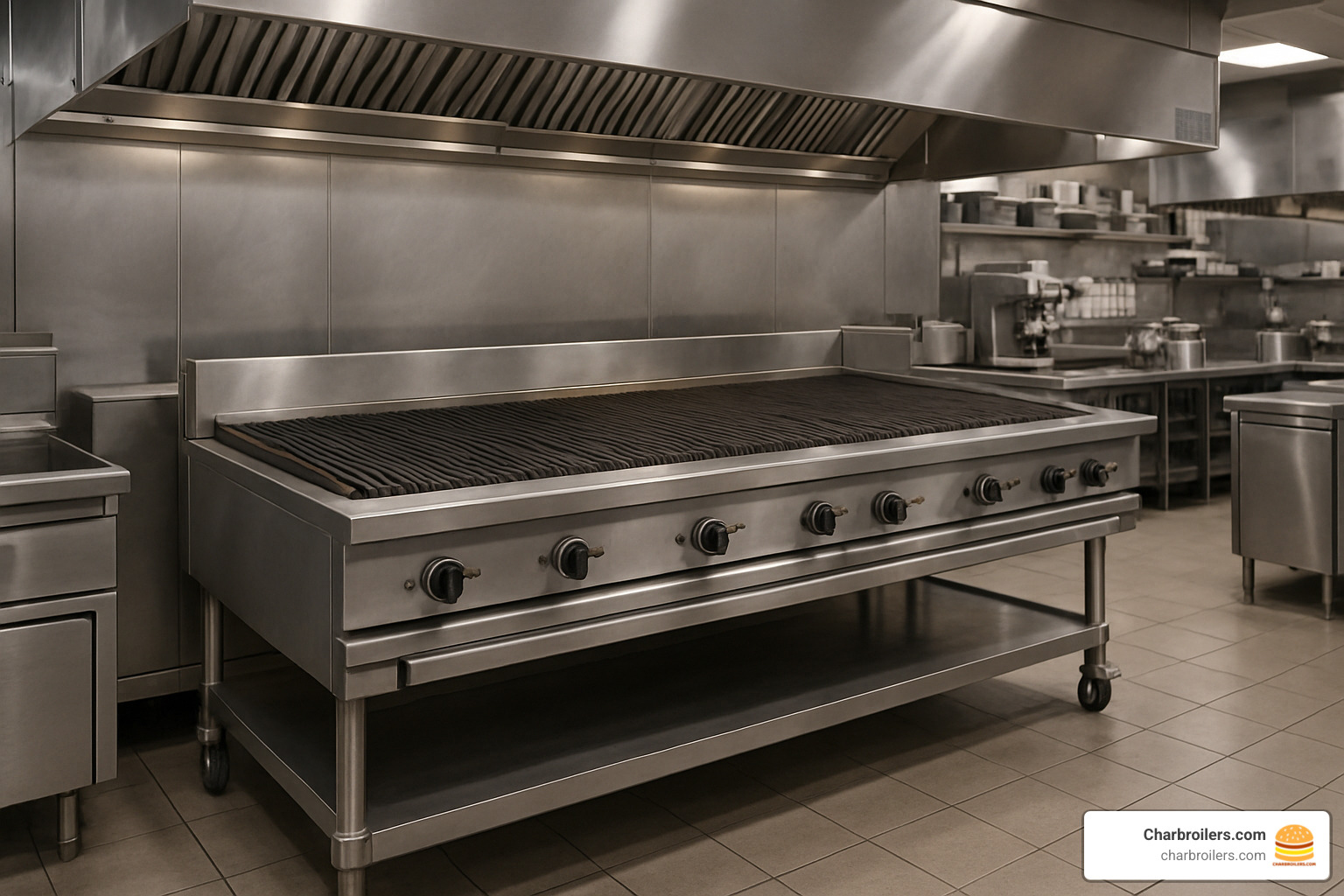
These brawny kitchen centerpieces come in widths up to a whopping 84" and can house as many as 20 burners with total heat output reaching 360,000 BTUH in the largest models. That's enough firepower to handle even the busiest Saturday night dinner service without breaking a sweat.
Beyond raw cooking power, freestanding commercial charbroilers offer practical advantages that make your kitchen life easier. Many feature built-in storage underneath – perfect for keeping tools, supplies, and even backup grates within arm's reach. Models with casters let you roll the unit out for thorough cleaning (your maintenance staff will thank you), while integrated features like warming racks and adjustable backsplashes add functionality without consuming additional kitchen real estate.
I've watched restaurant owners literally smile with relief when they upgrade from an overworked countertop unit to a properly-sized floor model and suddenly find themselves keeping up with ticket times even during the dinner rush.
Modular & Outdoor Flexibility
Some kitchens call for more specialized solutions, which is where modular drop-in units and outdoor models come into play.
Modular commercial charbroilers are designed to integrate seamlessly with other cooking equipment, creating a unified cooking line with a cohesive look. These are particularly popular in exhibition kitchens where guests can watch their meals being prepared. There's something mesmerizing about watching a skilled chef manage a row of steaks on a gleaming built-in charbroiler – it's dinner and a show rolled into one.
For restaurants blessed with outdoor space, weather-resistant charbroilers extend your cooking capabilities beyond the kitchen walls. These specialized units feature reinforced construction to withstand the elements and safety features designed specifically for open-air cooking environments. Resort patios, seasonal restaurant extensions, and catering operations particularly benefit from these robust outdoor options.
Some of our most memorable installations have involved custom modular charbroilers built into stone or brick surrounds for exhibition kitchens. These become dramatic focal points that draw customers' attention while delivering the serious cooking performance professional chefs demand.
Whether you're working with a postage-stamp kitchen or planning a sprawling cooking line, there's a commercial charbroiler configuration designed to fit your space, support your menu, and help your kitchen perform at its best.
Choosing the Right Heat Source for Commercial Charbroilers
When it comes to selecting a heat source for your commercial charbroiler, you're not just making a technical decision – you're choosing the foundation of your menu's flavor profile. Let's walk through your options together, like we would if you visited our showroom floor.
Gas Commercial Charbroilers
There's a reason gas models remain the darling of professional kitchens everywhere. Whether fueled by natural gas or liquid propane, these workhorses give chefs what they need most: control.
With gas charbroilers, you'll enjoy responsive heat adjustments that let you pivot from searing steaks to gently finishing more delicate items. They fire up quickly – typically ready for action in just minutes – and deliver impressive output between 15,000-40,000 BTU per burner without breaking the bank on operating costs.
Gas charbroilers come in two main heating designs that create distinctly different cooking experiences. Radiant systems use metal shields that distribute heat evenly while keeping drippings from reaching the burners. Think of them as the reliable, low-maintenance option that delivers consistent results service after service.
Their cousins, lava rock systems, use volcanic stones that catch those flavorful meat drippings and vaporize them right back into your food. The result? An extra dimension of smoky goodness that many chefs swear by. Just know you'll be cleaning those rocks regularly to keep things running smoothly.
Electric Commercial Charbroilers
"But what if I can't run gas lines?" I hear this question often, especially from clients in historic buildings or temporary locations. That's where electric models shine.
Electric charbroilers offer remarkable installation flexibility – just plug in and you're cooking. They produce no combustion byproducts, which can mean simpler ventilation requirements in some jurisdictions. The heat distribution tends to be wonderfully even across the cooking surface.
While your utility bill might run higher than with gas (depending on local rates), the installation savings and convenience can make electric models the smart choice for certain situations. One café owner in a century-old building told me his electric charbroiler was "the difference between having grilled items on the menu and not having them at all."
Solid-Fuel Commercial Charbroilers
For those seeking the ultimate flavor experience, nothing compares to the primal appeal of wood or charcoal. These solid-fuel charbroilers create distinctive flavor profiles that vary with your choice of wood – hickory, mesquite, apple, cherry – each imparting its own character to your food.
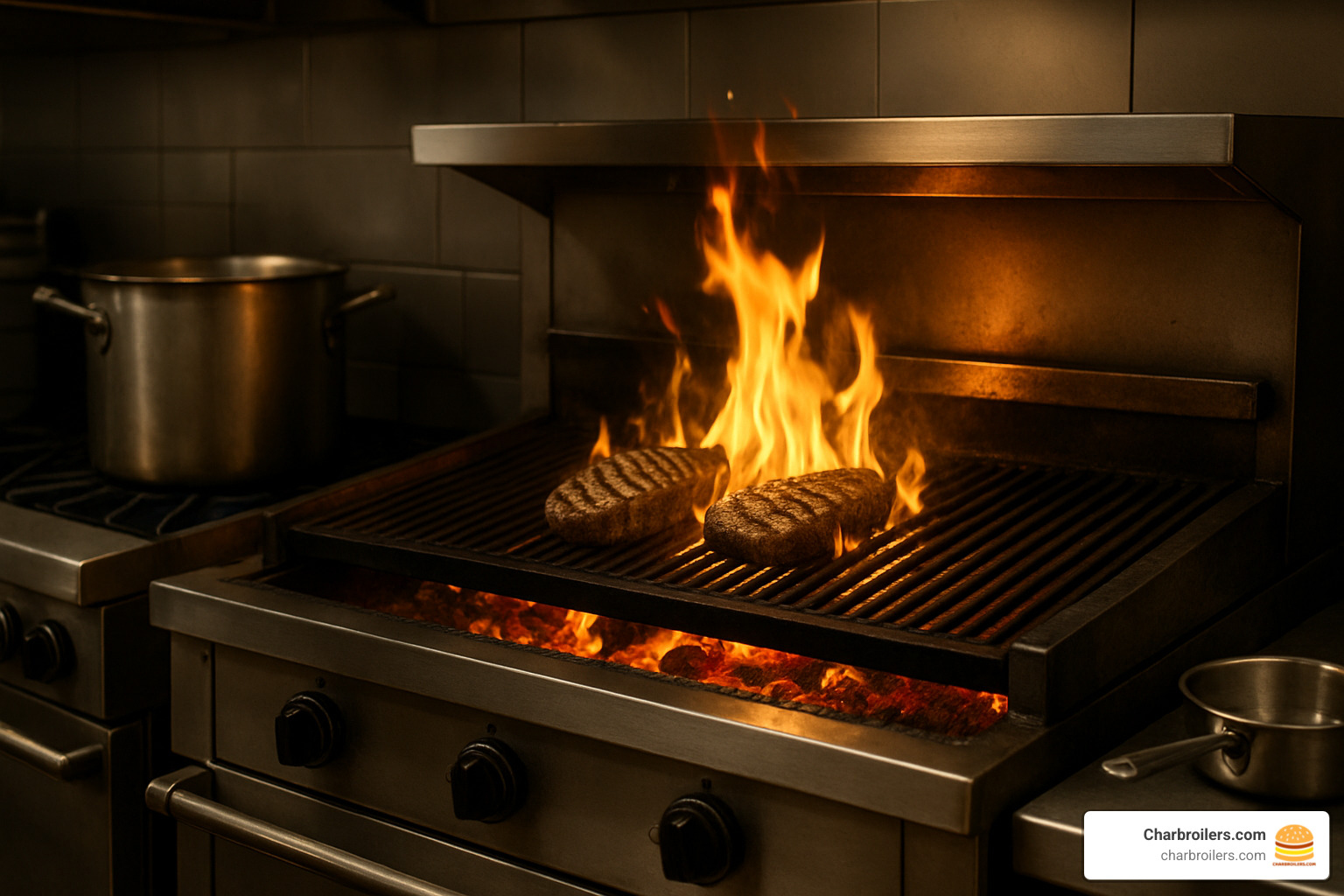
Beyond taste, there's undeniable marketing appeal in visible flames and the aromatic smoke that wafts through your dining room. Yes, these units demand more attention and maintenance, but for concepts where authentic wood-fired flavor is your calling card, many chefs find the extra effort worthwhile.
Radiant vs. Lava Rock Commercial Charbroilers
This is one of the most common debates I have with chefs looking at gas models. Here's the straightforward breakdown:
Radiant charbroilers use metal plates to spread heat evenly. They're the practical choice – easier to clean, more consistent in performance, and the components typically last longer. Most high-volume kitchens gravitate toward these models because they deliver reliability shift after shift.
Lava rock charbroilers create that authentic charcoal-like flavor that many chefs desire. The porous volcanic stones catch drippings and create more smoke, infusing food with deeper flavor notes. There's also something undeniably appealing about the visual of those glowing rocks beneath your steaks. Just remember – you'll be rotating and replacing those rocks as part of your maintenance routine.
Infrared Commercial Charbroilers Efficiency
If efficiency keeps you up at night (and with today's energy costs, it should), infrared technology deserves your attention. These cutting-edge commercial charbroilers have been game-changers for many of our customers.
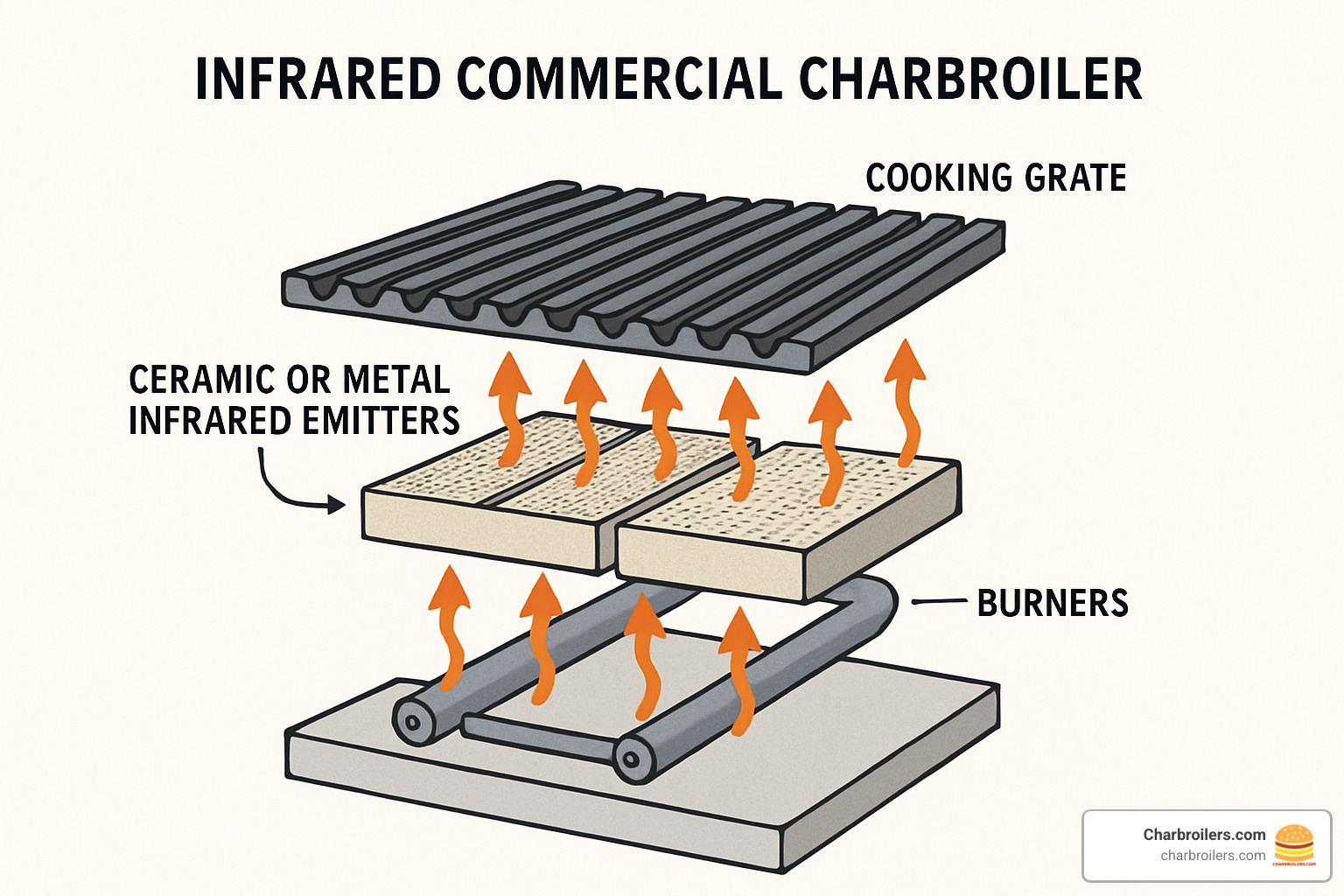
Using specialized ceramic or metal emitters, infrared charbroilers convert gas energy directly into infrared radiation. This more efficient heating method can reduce gas consumption by up to 30% while cooking food faster and more evenly. Flare-ups become much less common, creating a more controlled cooking environment.
I still smile thinking about the steakhouse owner who called me after switching to an infrared model. "My line cooks actually have time to breathe during Friday night service now," he told me. His gas bill had dropped by nearly a quarter, but the faster cooking times during rush periods proved even more valuable.
The science behind this efficiency is well-documented. The U.S. Department of Energy's research on energy-efficient cooking equipment has consistently shown that infrared technology offers significant advantages, especially in high-volume applications.
While infrared models typically come with a higher price tag upfront, the operational savings often provide impressive ROI for busy kitchens. At Charbroilers.com, we can help you calculate exactly what that payback period might look like for your specific operation.
Key Features, Sizing & Configuration
Picking the right commercial charbroiler isn't just about finding something that cooks food—it's about finding a piece of equipment that becomes an extension of your culinary vision. Let's walk through the features that will make or break your charbroiling experience.
Adjustable vs. Fixed Grates – Which to Pick?
I've seen this debate play out in countless kitchens, and the truth is, both options have their place depending on your cooking style.
Adjustable grates give you the freedom to customize your cooking surface. With typically 3-4 different angle positions, you can create varied cooking zones across your broiler. This flexibility is perfect when you're juggling rare steaks, well-done burgers, and delicate fish all during the same service. The tilting action also helps manage grease by directing drippings away from flames, reducing those heart-stopping flare-ups during a busy rush.
On the flip side, fixed grates offer beautiful simplicity. They're generally more affordable upfront and have fewer moving parts that could potentially break down. For kitchens with a consistent menu (like a burger-focused concept) or those with high staff turnover, fixed grates provide reliable performance without requiring additional training or adjustment during service.
When I visit restaurants considering a new charbroiler, I often ask: "How often will your menu change, and how diverse are your grilled items?" The answer usually points clearly toward which grate style makes more sense.
Grate Materials That Last
The material beneath your food dramatically affects both performance and longevity of your commercial charbroiler. Let's break down your options:
Cast iron grates are the traditional choice, and for good reason. They hold heat like nothing else, creating those deep, distinctive sear marks that make customers' mouths water. When properly seasoned (a process that builds up a natural non-stick surface), cast iron develops character over time, much like a well-loved cast iron skillet. However, they do require more maintenance and can rust if not properly cared for.
Stainless steel grates shine in environments where maintenance might be less consistent or in humid kitchens where rust is a concern. They're remarkably easy to clean and maintain their appearance over time without requiring seasoning. While they won't hold heat quite as as cast iron, many chefs appreciate their consistent performance and longevity.
Chrome-plated grates offer a happy medium—they release food more easily than cast iron (a blessing when cooking delicate items like fish) while being simpler to clean than either alternative. They don't retain heat quite as well, but for high-volume operations where quick cleaning between services matters, they're worth considering.
At Charbroilers.com, we've found that steakhouses and burger joints typically gravitate toward cast iron for those picture-perfect grill marks, while seafood restaurants and kitchens with varied menus often prefer the versatility of stainless steel or chrome options. You can learn more about these options on our guide to commercial charbroilers.
Sizing Your Broiler to Your Menu & Line
Finding the right size commercial charbroiler is a bit like Goldilocks—too small and you'll create a bottleneck during service; too large and you're wasting valuable kitchen real estate and energy.
Here's a practical approach to sizing: for most restaurants, plan for approximately 12-15 inches of grill space per 50 seats in your dining room. If you're running a burger-focused concept, you can calculate more precisely—expect to cook about 20-24 burgers per hour for each foot of grill space.
Standard widths typically run from 24" to 72" in 12" increments, though we can certainly help with custom sizes for unique kitchen layouts. Depth matters too—models range from 24" to 36" deep, with deeper units offering more cooking area but requiring larger hood systems.
Integration with your existing line is crucial. Your charbroiler needs to work harmoniously with the rest of your kitchen equipment, both physically and in terms of workflow. Consider the relationship between prep areas, the broiler station, and plating areas. Commercial charbroilers require proper clearance from combustible materials (typically at least 6 inches) and must fit under your ventilation hood.
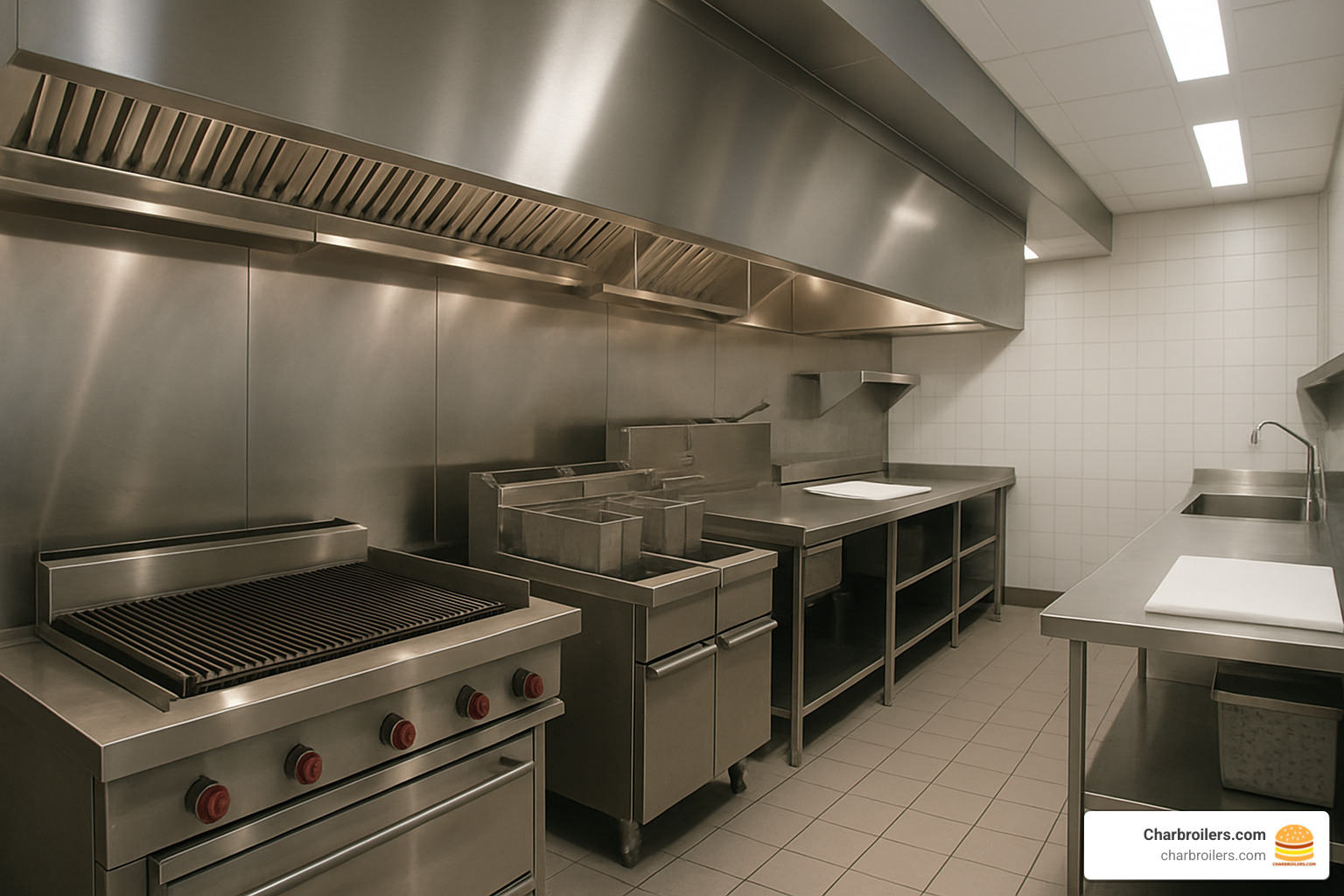
One of my favorite services to offer at Charbroilers.com is our free kitchen layout consultation. We'll help you determine not just which broiler is right for your menu, but exactly how it should integrate with your existing setup to create the most efficient workflow possible. After all, a perfectly sized charbroiler in the wrong location can be just as problematic as choosing the wrong equipment in the first place.
Maintenance, Operating Costs & Troubleshooting
Taking care of your commercial charbroiler isn't just about keeping it clean—it's about protecting your investment and ensuring those perfect grill marks keep coming day after day. Think of maintenance as the secret ingredient to a long-lasting relationship with your kitchen's star performer.
Cleaning Best Practices for Peak Performance
Ever notice how a freshly cleaned charbroiler just seems to cook better? There's a good reason for that. Regular cleaning prevents the kind of stubborn grease buildup that can turn your prized equipment into a fire hazard waiting to happen.
At the end of each shift, take a few minutes to scrape those grates while they're still warm—the residue comes off much easier this way. Empty those grease trays before they overflow (trust me, you don't want that mess on your floor during a busy service). A quick wipe-down of exterior surfaces keeps things looking professional for open-kitchen concepts.
Weekly, you'll want to go a bit deeper. Remove the grates for a thorough cleaning and check on your burners and heat deflectors. It's like giving your commercial charbroiler a mini spa day—and it'll thank you with better performance.
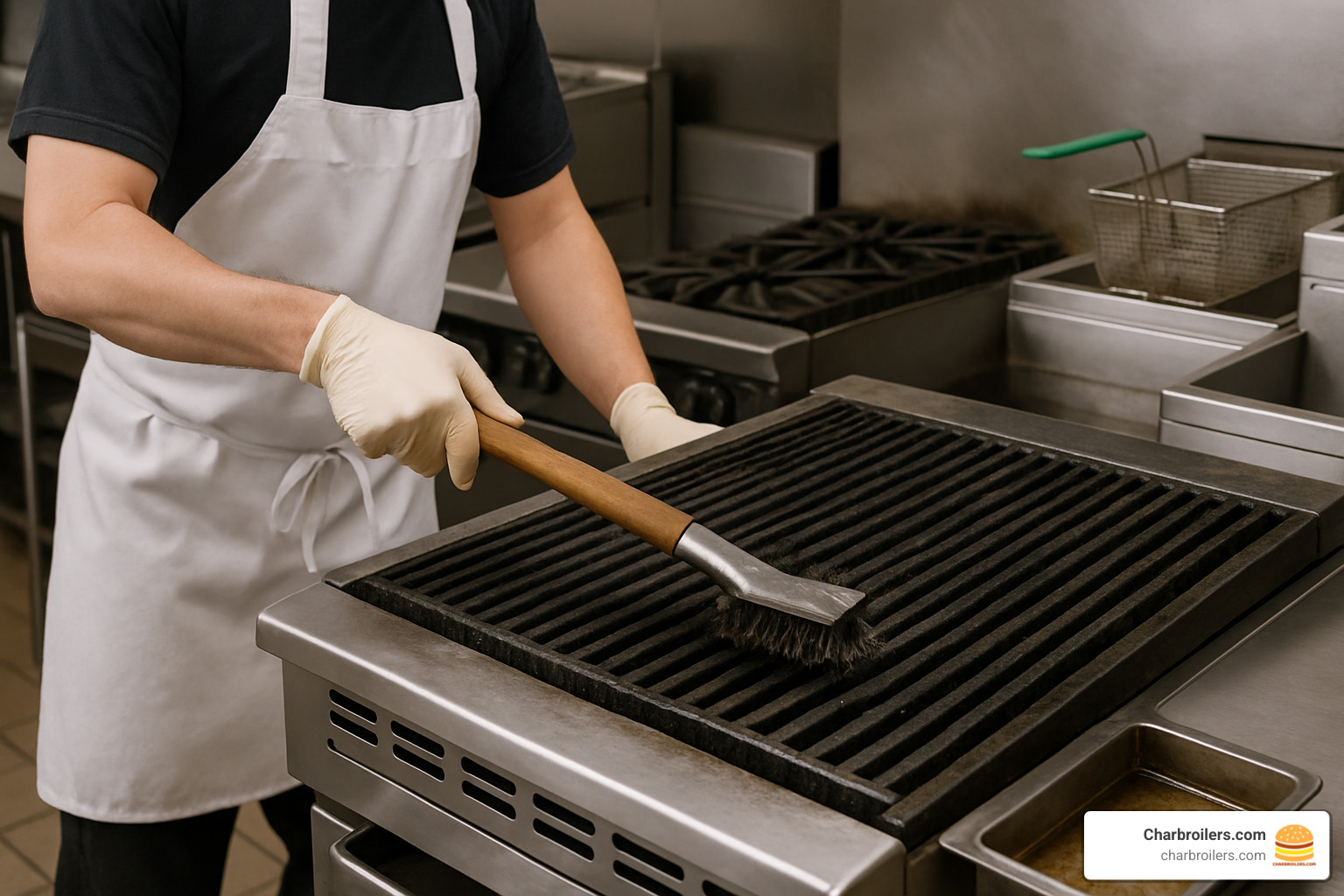
Once a month, set aside time for the deep clean your equipment deserves. This means taking apart the removable components and really getting into those nooks and crannies. If you're running a lava rock system, remember to rotate those rocks monthly and replace them every 3-6 months—they're working hard for your flavor profile and eventually need refreshing.
For the infrared crowd, those emitter plates need special attention to stay free of debris. Think of them as the precision instruments they are—even small bits of carbonized food can affect their performance.
Common Issues & Fixes for Commercial Charbroilers
Even the best commercial charbroilers occasionally have off days. Knowing what to look for can save you a service call and keep your kitchen running smoothly.
Uneven heating is one of the most common complaints we hear at Charbroilers.com. Before panicking, check for clogged burners or damaged radiants—these are often the culprits. A quick cleaning or component replacement might be all you need. If that doesn't solve it, your gas pressure might need adjustment.
When those dramatic flare-ups start happening more frequently, it's usually telling you something. Your charbroiler is practically begging for a deep clean, or perhaps your grates need repositioning. Sometimes it's as simple as adjusting the angle of your grates to better manage grease flow.
Nothing stops service faster than ignition failures. Start by checking the basics—is the pilot light dirty? Is your igniter working properly? These small components make a big difference in whether you're cooking or standing around waiting.
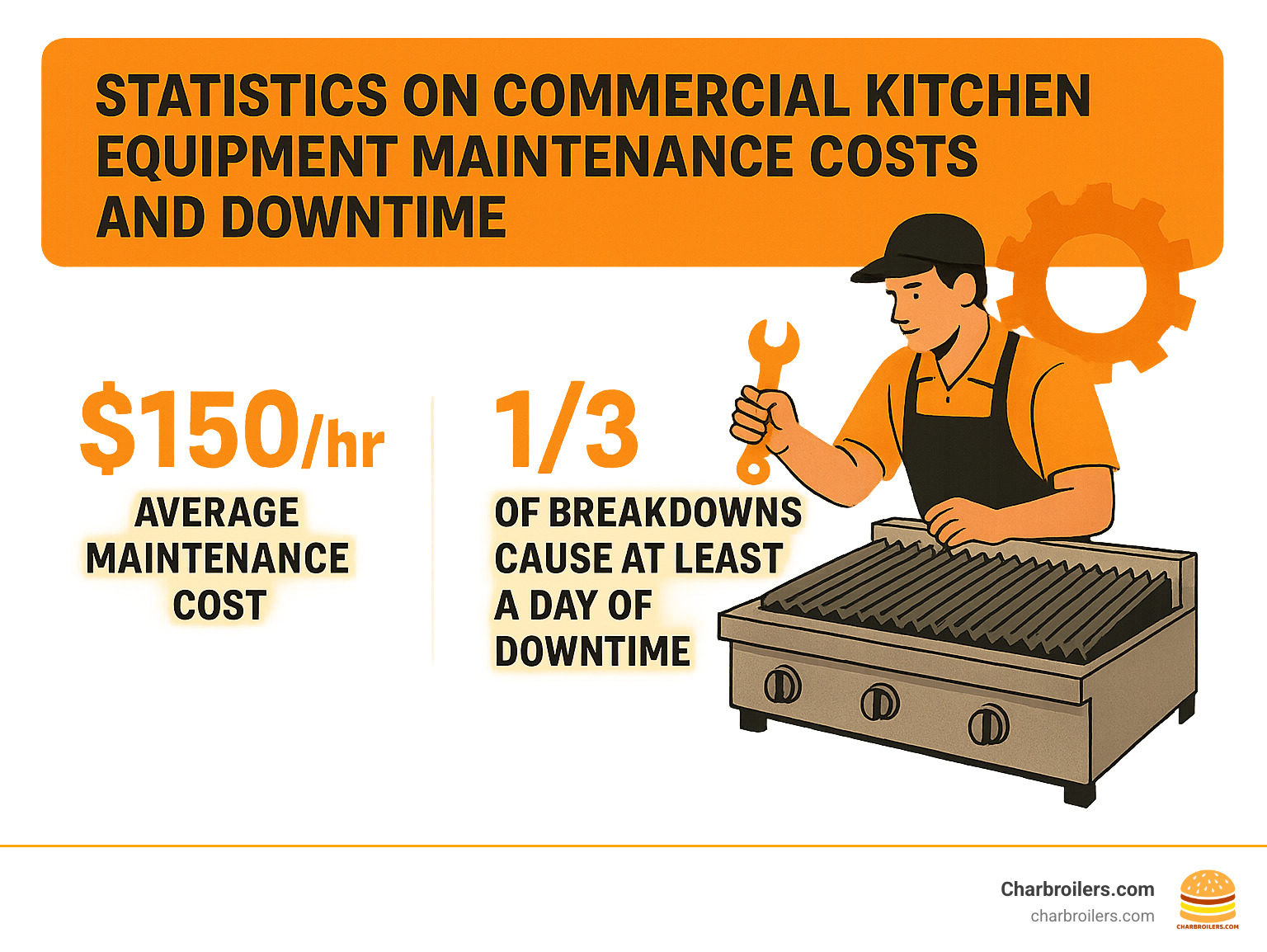
When those beautiful grill marks start looking more like faint suggestions, your customers will notice. Make sure you're giving your charbroiler enough time to preheat—rushing this step is a common mistake during busy service. If your grates are worn down after years of faithful service, it might be time for replacements.
And let's talk about smoke and odor issues—because your dining room shouldn't smell like a grease trap. Excessive smoke usually points to built-up grease or ventilation problems. Check that your hood system is functioning properly and that airflow isn't obstructed.
Our Seattle-based service team at Charbroilers.com often reminds customers that preventative maintenance plans are like insurance for your equipment—they seem optional until suddenly they're not. Regular professional service typically pays for itself through improved efficiency and fewer emergency repairs during your busiest times.
Tracking your utility bills can also reveal early warning signs of efficiency problems. If your gas consumption suddenly increases without a corresponding increase in production, something's likely amiss with your commercial charbroiler. Catching these issues early not only saves money but prevents that dreaded equipment failure during your Saturday night rush.
Frequently Asked Questions about Commercial Charbroilers
How much ventilation does a charbroiler require?
Let's talk ventilation - it's not the most exciting topic, but it's absolutely critical when installing a commercial charbroiler. These powerful cooking machines generate significant heat and smoke, which is why proper ventilation isn't just recommended—it's required by code.
Most jurisdictions require Type I hood systems with built-in fire suppression capabilities positioned directly above your charbroiler. The hood typically needs to extend 6-12 inches beyond your equipment on all open sides to properly capture smoke and heat.
When planning your kitchen layout, keep in mind that exhaust capacity generally runs between 150-350 CFM (cubic feet per minute) per linear foot of hood, with the exact requirement varying based on your specific charbroiler type. Gas and solid-fuel models typically need more robust ventilation than electric units.
Don't forget about make-up air! Your kitchen needs to replace 80-90% of the air being exhausted, or you'll create negative pressure that affects everything from door operation to equipment performance. We've seen kitchens where poor make-up air planning led to doors that wouldn't close and pilot lights that wouldn't stay lit—headaches you definitely want to avoid.
Since local codes can vary dramatically, we always recommend consulting with a kitchen ventilation specialist during your planning phase. Our design team at Charbroilers.com can help coordinate with your ventilation contractor to ensure everything works together seamlessly.
Can I switch from lava rock to ceramic radiant later?
This is a question we get surprisingly often, and the answer is: it depends on your specific model. Many gas commercial charbroilers can indeed be converted between lava rock and radiant systems, but not all are designed with this flexibility in mind.
If you're considering a potential future conversion, pay attention to the original design of the unit you're purchasing. Some charbroilers are engineered specifically for one system or the other, while others offer more adaptability. Manufacturer-approved conversion kits are available for many popular models, making the switch relatively straightforward.
That this kind of conversion will change how heat distributes across your cooking surface. Radiant systems typically provide more even heat, while lava rock creates more localized hot spots that some chefs actually prefer for certain cooking techniques.
One important note: unauthorized modifications can void your equipment warranty, so always use manufacturer-approved components and professional installation. At Charbroilers.com, we can help identify models that offer this adaptability, potentially saving you from having to replace your entire unit down the road if your cooking needs evolve.
What foods benefit most from charbroiling?
While a commercial charbroiler can handle almost anything you throw at it, certain foods truly shine with this cooking method. The combination of intense heat, smoke flavor, and distinctive grill marks creates culinary magic with the right ingredients.
Proteins are charbroiler superstars. Steaks develop that perfect sear with beautiful caramelization while maintaining a juicy interior. Burgers get that backyard cookout flavor that customers crave. Chicken develops crispy, flavorful skin while staying moist inside. Even seafood—particularly firmer varieties like salmon, swordfish and tuna—benefit from quick cooking and those appetizing grill marks.
Vegetables undergo a delicious change on the charbroiler. Bell peppers develop a sweet, smoky char that improves their natural flavors. Onions caramelize beautifully, bringing out their natural sweetness. Corn, eggplant, zucchini and summer squash all take on new dimensions of flavor while maintaining their texture.
Some unexpected items really shine on the charbroiler too. Firm fruits like pineapple and peaches develop caramelized sugars that create dessert-worthy flavors. Certain specialty pizzas benefit from a quick finish on the charbroiler. Even bread and firm cheeses like halloumi develop beautiful marks and improved flavor profiles.
Our culinary team loves helping customers find new menu possibilities for their charbroilers. We've seen restaurants create signature dishes that keep customers coming back specifically for that distinctive charbroiled flavor that's impossible to replicate with other cooking methods.
Conclusion
Selecting the right commercial charbroiler represents a significant investment in your kitchen's capabilities and your menu's flavor profile. The perfect unit balances your space constraints, production needs, energy considerations, and culinary goals.
At Charbroilers.com, we've spent over a decade helping restaurant owners and chefs throughout Seattle and beyond find their ideal charbroiling solutions. Our experience has shown that the right equipment pays dividends through operational efficiency, consistent food quality, and distinctive menu offerings that keep customers coming back.
Whether you're opening a new restaurant, upgrading existing equipment, or expanding your kitchen's capabilities, we offer:
- Expert consultation on equipment selection
- Professional kitchen design services
- Competitive financing options custom to food service businesses
- Installation coordination with certified technicians
- Ongoing maintenance and support
We invite you to visit our Seattle showroom to experience different charbroiler models in person, or browse our complete selection online. Our team is ready to help you steer the options and find the perfect charbroiler for your unique operation.
The right commercial charbroiler is more than just cooking equipment—it's a cornerstone of your kitchen's workflow and your menu's identity. With proper selection, maintenance, and operation, it will serve as a reliable partner in your culinary success for years to come.
For more information about professional selection and design services, visit our guide to commercial charbroilers or contact our team directly. We're fired up about helping you find the perfect solution!
